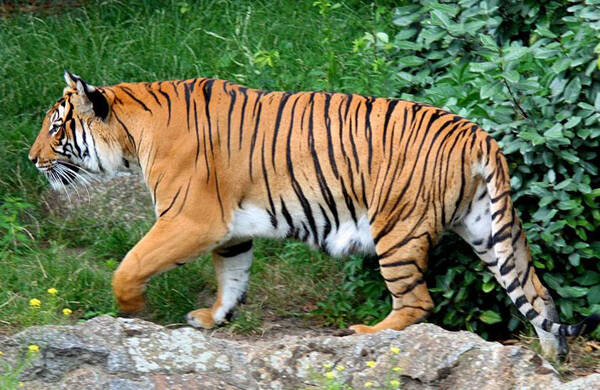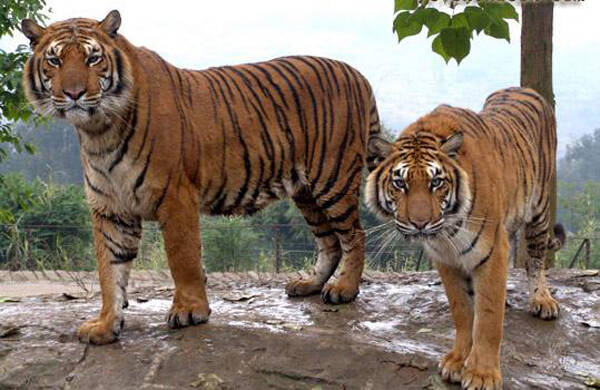Panthera tigris corbetti
IUCN
LCBasic Information
Scientific classification
- name:Panthera tigris corbetti
- Scientific Name:Panthera tigris corbetti,Indochinese tiger, Corbett tiger
- Outline:Carnivora
- Family:Schizopoda Felidae Panthera
Vital signs
- length:2.3-2.85m
- Weight:100-195kg
- lifetime:About 20 years
Feature
Compared to other tigers, it has darker fur and shorter, narrower stripes.
Distribution and Habitat
It is mainly distributed in Indochina, Myanmar, Thailand, Laos, Cambodia, Vietnam, southwest China and Medog County. However, no traces of this subspecies have been found in China since 2007.
It likes to live in tropical and subtropical rainforests, dry and moist deciduous forests, evergreen forests, and broad-leaved forests. It mainly lives deep in the woods in mountainous areas. It is related to its preference for forests.
Appearance
The male Indochinese tiger is 2.55-2.85 meters long and weighs 150-195 kilograms; the female tiger is 2.30-2.55 meters long and weighs 100-130 kilograms. It is a smaller tiger subspecies.
The tiger has a majestic body, beautiful fur, round head, wide muzzle, big eyes, and white and black hard whiskers around the mouth, which are about 15 centimeters long. The neck is thick and short, almost as wide as the shoulders. The shoulders, chest, abdomen and hips are narrow and flattened laterally. The limbs are strong, the canine teeth and claws are extremely sharp, and there are long and hard tiger whiskers on the mouth. The base color of the whole body is orange-yellow, the belly and the inner side of the limbs are white, there are two rows of black vertical stripes on the back, there are about 10 black rings on the tail, and there is a white area above the eyes.
At first glance, this subspecies is very similar to other tigers, but the fur color is darker, the stripes on the body are s
Details
The Indochinese tiger has the ability to camouflage itself in tall grass and trees and is a solitary animal. They have a strong sense of territory and their sociality only occurs during the mating season. Others of the same sex are not allowed in their territory.

Indochinese tigers can breed all year round, as long as they reach sexual maturity, about 3.5 years for females and 5 years for males. However, mating is most common between early April and November. The gestation period is 3.5 months, about 103 days. A female tiger can give birth to up to 7 cubs in one litter. The cubs are born with their ears and eyes closed, but it takes only a few days for them to start functioning. The cubs are nursed by their mother for 18-28 months. The lifespan in the wild is about 20 years.
Inbreeding is most common in this subspecies of Indochinese tigers, which is mating between individuals with direct blood genetic relationship, resulting in weak and defective genes, reduced sperm production, fertility and infertility problems. As a result, the mortality rate of cubs is very high, ranging from 35-73%.

Because many Indochinese tigers live in remote forests at the borders of various countries, access to areas where Indochinese tigers live is often restricted, biologists have limited permits to conduct field surveys, and much is still unknown about the status and living conditions of these tigers in the wild. It is estimated that only 1,200-11,800 Indochinese tigers remain in the wild.
The status of the Indochinese tiger is less well known than that of other tiger subspecies, but its decline is severe, approaching the critically endangered threshold. Until the 1980s and 1990s, tigers were thought to be widespread in the region, but little research was done. However, as of 2010, tigers are not found in a wide area of Southeast Asia, and there is no evidence of breeding tigers in Cambodia or Vietnam; Myanmar has only one potentially viable population in the Hukaung Valley Wildlife Sanctuary, and Laos has only one confirmed population of tigers, with fewer than 20 mature individuals. Government estimates of national tiger populations put the subspecies population at 352: Thailand (200), Myanmar (85), Vietnam (20), Cambodia (20), and Laos (17) (GTRP 2010). Records are rare in China (Yunnan Province and Medog County, Tibet), where tigers are probably not resident but dependent on transboundary protected areas with India and Myanmar (2010). However, estimates for these countries remain somewhat speculative, with the number of tigers in confirmed protected populations in these countries being significantly lower, totaling 202 individuals: 185 in Thailand and 17 in Laos. In Cambodia, despite extensive surveys, there have been only a few confirmed tiger records since 2005 (2010). In Vietnam, tigers have not been captured on camera since 1997 (as of 2010). In the world's largest tiger reserve, Myanmar's Hukaung Valley, camera-trap surveys found only six individual tigers, and due to lack of data, a wide range of estimates of 7-71 adult and sub-adult tigers were used, concluding that the decline in numbers "may be due to high activity of tigers." Research on prey and tigers. In 2007, the subspecies was assessed as Endangered, with a total population of well under 2,500 individuals, no more than 250 individuals in a single subspecies, and continuing to decline. It appears to be approaching the critically endangered threshold, and will be fully assessed to determine that it does meet these criteria for the next Red List update.

The populations in Laos and Vietnam are already in danger. The number in Myanmar was estimated to be only about 85 in 2015. The population in Thailand is also facing a survival crisis. The Indochinese tiger has become the fastest declining tiger subspecies, and it is estimated that the total number in 2016 may be less than 400, and it is urgent to strengthen protection and restore the population.
Habitat loss caused by deforestation is the culprit for the decline in the Indochinese tiger population. Hunting is listed as the main threat, followed by the threat of habitat degradation caused by the continued concession of resource extraction (timber, oil and gas, minerals, etc.).
left;"> In February 2009, villagers from the Dachoushui Group of the Mannasan Village Committee of Mengla Town, Mengla County, shot and killed an Indochinese tiger in the nearby Shangyongzi Nature Reserve of the Xishuangbanna National Nature Reserve. On December 21, 2009, the People's Court of Mengla County pronounced the first-instance verdict on the illegal hunting of "Indochinese tigers".
Yunnan Province, China has done some work in protecting Indochinese tigers. By the end of 2012, Yunnan had built 156 nature reserves of various types, with a total area of 2.81 million hectares, accounting for 7.1% of the province's land area. In particular, six national and provincial nature reserves, including Xishuangbanna, Nangun River, Huanglian Mountain, Jinping Watershed, Gaoligong Mountain, and Tongbiguan, have been established in the tiger distribution area, protecting endangered animals such as Indochinese tigers as important protection objects.
In 2016, according to the latest scientific survey, Cambodia's Indochinese tigers have become functionally extinct, and plans are being made to import seven Indochinese tigers from neighboring countries to restore wild populations. The World Wildlife Fund believes that the forests in the lower reaches of the Mekong River can be used as habitats and prey bases, and there is a possibility of reintroducing tigers. There is also potential for wild tiger population recovery in southern Laos and central Vietnam.
Listed in the "Red List of Endangered Species of the World Conservation Union" (IUCN) 2011 ver 3.1-Endangered (EN).
Protect wildlife and eliminate game.
Maintaining ecological balance is everyone's responsibility!








